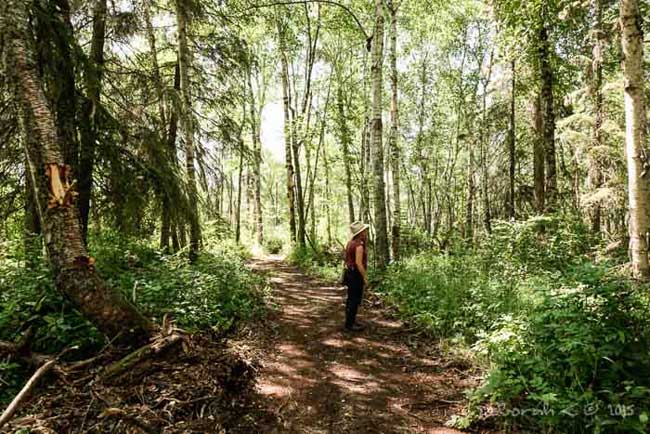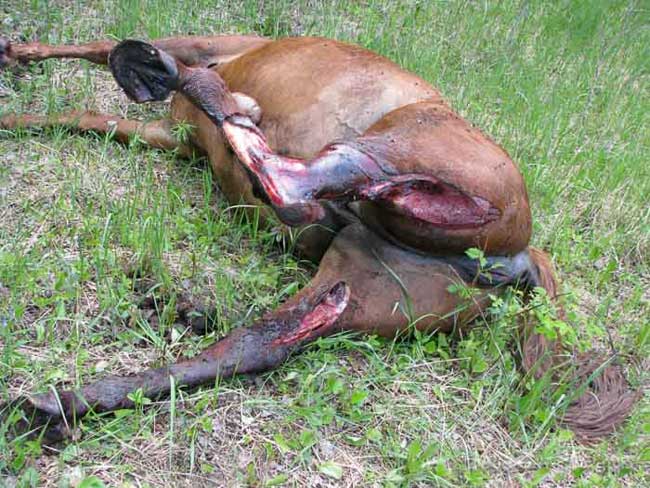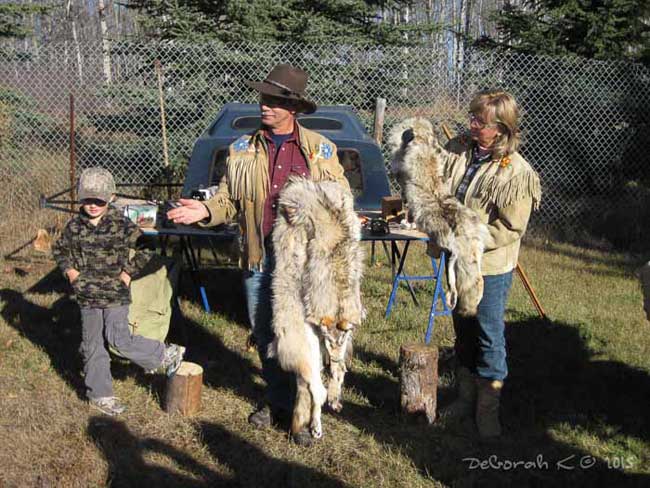
The number one threat to all wildlife in North America is loss of habitat. Let me explain why I feel it necessary to stand on this statement, in the context of trapping wolves in Canada.
Habitat and carrying capacity – these are unavoidable issues that need to be addressed by all those involved in this controversy, from industry to agriculture to municipalities, conservationists, wildlife protectors, and everyone in between.
Wolves are at the top of the food chain in many of our forested regions in this country. The regions that they are utilizing as habitat are sometimes unable to sustain the population as wolves continue to produce offspring.
My heart lies in addressing what I believe is the real issue. In discussing wolves, I’d like to begin with population dynamics.
Habitat and Population Dynamics
Using the example of a pack of seven wolves, the adult females could birth seven pups in the spring. The mother cares for the pups during their early weeks of life, and the male goes out to hunt and returns with food, so she can concentrate on raising the pups. The entire pack is involved with the raising of the young. The mortality rate is lower than other wildlife because of this.
The habitat they are ranging in could be from 100 to 250 square miles depending on the available food in that habitat.
If all seven pups survive and are healthy, they will reach the size of their mother by the end of the fall season and coming of winter.
That means that the winter that follows the spring birthing, there will now be 14 wolves in that pack. The need for food for this pack will have doubled in less than a year.
So now we have seven pups that will be trained how to kill in order to survive and be an integral part of the pack. This is in one year and the math shows the results after five years is enormous for the same habitat and food source. Some may break away, some will die, but this is the top of the food chain with no predators that are preying on the wolf.
I want to be clear on this point: letting nature take care of itself by allowing it to sort itself out, like nature used to do in generations past, is no longer a viable and responsible option. It is imperative for us to take responsibility to manage the over-population of the wolves.
Nature will cull the numbers through disease, starvation, etc., but as one who has spent the better part of my life involved in wildlife control, it is not a humane thing to witness. If any animal is going to die then it has been my job to see that it is done humanely and as quickly as it can be done.
It then becomes quite obvious that the numbers of wolves in excess of the carrying capacity of the habitat, these animals will need to be removed.
Public Perception
There is a void in the public perception, and an idolizing of wolves that is not helping to protect, but instead is a hindrance!
The simple fact remains contrary to many people’s understanding, we have wiped out so much habitat throughout North America, that this type of population growth will have an astounding effect on the prey species. I’ve seen the results upon horses, lambs, elk calves, moose, deer, caribou, bison and domestic pets.
Where suitable habitat exists, wolves have lived in close proximity to livestock for several years, with little predation issues. But, how long in any area before the growth number of the wolf packs exceeds the available habitat and food source causing livestock and predation problems?
It’s an obvious fact something must be done to control population levels. The most important thing for us to consider is this! There is a need to work together to ensure that if there is a culling process taking place, it should happen in the most humane and effective method available.

Trapping – Viable Option?
Trapping is often viewed as a hated solution to population controls, but under the humane trapping standards, utilizing modern equipment, it still remains as one of the best options. Performed in the winter months, when the young are not being nursed, the pack numbers have peaked since the summer and the carrying capacity will now have more pressure on it. The fur will not be wasted and can be a resource to be utilized.
It is an industry that, through provincial wildlife laws, takes the approach of removing the surplus of furbearers, many of which will not find enough suitable habitat in the winter months to survive. This is a simple fact and has enough data and documentation to show a very successful program that continues to be a key element in the health and survival of these animals.
I believe that is something to be proud of as wise use of management!
I can think of no country in the world that does not trap. They may have stopped fur trapping but it still continues and is then called “wildlife control” or “animal damage control” which must be done, to control over-population of species as they continue to produce more offspring than the habitat can sustain. These animals are not used for anything and are treated as vermin and are incinerated or treated as trash. This is not true wildlife management. We are better than this. The carcass of that animal is used by trappers and taken back out to the land to feed other carnivores. The fur is prepared and shipped and sold to be tanned and used.
There is no “nice part” of the dying of any living thing and nothing works perfectly, but we have come a long way and Canada continues to be the world leader on humane trapping standards. There are many pictures circulated throughout public media showing the mistakes made by untrained individuals and just plain carelessness causing suffering and pain, but as a professional I can assure you this is not the norm.

Carrying Capacity
Human encroachment into wolves’ habitat results in conflict that is unavoidable. So, we have created the problem, and we need to take responsibility to manage it. Wolves are predators, and whether we want to view the destruction or turn away from it, will not make it go away.
It is sometimes difficult for some to consider their lifestyle in relation to loss of habitat for wildlife. We are all consumers by the way we live. We may not eat meat but if we use toilet paper, magazines, books or newspapers, or if we buy lumber to build a bird house or picnic table, we are supporting a lumber industry, which is taking out habitat.
If we use oil, gasoline, plastic etc., we are supporting an oil industry that is wiping out habitat. The point being here that we are all in this together. Nature is not something separate from us and it never will be. We can’t survive without it.
There is a direct link between our choices to buy more and more stuff, traveling less distances to get it, and habitat that is being lost at an alarming rate. Less destruction of habitat is an absolute if you are going to preserve the current wolf population dynamics.
ALSO BY ROSS HINTER: WILDLIFE CONTROL EXPERT OR TRAPPER? WHO YOU GONNA CALL?
Final Thoughts
As always, knowledge and understanding are powerful tools. In such an emotionally charged time in human history and love of wildlife, those that hate the wolves and those that love the wolves will need to find a balance of true and clear knowledge of what is really taking place.
This includes a full understanding of loss of habitat. Instead of wasting so much time and money arguing about who is responsible, we would better serve the preservation of the species by collaborating together to find viable solutions that work long term. The money in this effort would then be well spent.
We have taken the habitat and continue to do so, therefore we are responsible to manage the population in the most humane and ethical manner available to us.
This is the sensible approach to a very heated conflict and one that is going to continue to make headlines.
My life as a professional trapper has proven to me what an important resource Canadian trappers are, both to the academic and scientific community, along with both provincial and federal government departments and conservationists at all levels.
Ethical trappers are the front line of conservation and will continue to be a valuable tool and play a key role in the welfare of our furbearing wildlife.
FOLLOW ROSS HINTER’S “BUSHCRAFT – LEARNING HOW” ON:













Hi I totally agree with the Trapping of Wolves I Only Started trapping Wolves in January 10/16 I ended my season with a total of 52 I know that there is a lot of wolves’ out in our Great Wilderness. I also noticed that with Removing the Wolves other animals started to come back I am a Certified Trapper as well as a Fur Buyer my 3 Trap lines keeps me very Busy in the Colder Seasons. Love your enthusiasm as well as very real comments
Enjoyed this information about the wolves. Fact filled article Thanks
This is an excellent article and should be used to help in the fight against the extreme animal rights freaks who don’t have a clue about life in the real world. Mother nature is not the kind, cute cuddly thing that Walt Disney has portrayed for so many years, or that PETA and their kind would have the gullible, uninformed masses believe. She is a cold, nasty bitch that exemplifies survival of the fittest. Us humans have no doubt caused major disruption in mother natures world by destroying so much of her habitat, and we are the only ones who are now able to try to maintain any sort of prey/predator balance.